Forum - View topicErrinundra's Beautiful Fighting Girl #133: Taiman Blues: Ladies' Chapter - Mayumi
|
Goto page Previous Next |
| Author | Message | |||
|---|---|---|---|---|
|
Errinundra
Moderator
Posts: 6584 Location: Melbourne, Oz |
|
|||
|
No fleet, no story, I guess.
I wasn't aware of how pivotal the Guadalcanal campaigns were for the outcome of the Pacific War until I read about them in my 30s. I get the impression that the Japanese themselves weren't aware how important they were until it was too late. They withheld their best capital ships for the great fleet action that never came. With the Americans getting control of Henderson Field and the seas around it, it was too late. (But I suspect you know all that.) |
||||
|
||||
|
Jose Cruz
Posts: 1796 Location: South America |
|
|||
Actually they explain in the series that both sides were evenly matched in terms of resources (even if the Empire call then "rebels") and that's why the war was going for as long as it did, then the military genius of Reinhard von Lohengramm disrupted the equilibrium. After the civil wars and the failed invasion of the Empire, just before their final confrontation, the Empire had like 60% of the galaxy's resources while the Alliance had 35% or something and 5% being neutral planets. Then reinhard launched his offensive on the Alliance and finally conquered the galaxy. In WW2 it was very different, Japan hoped only to convince the Western powers to give Japan most of East Asia, they were aware of their inferiority in resources but they didn't think that the western countries were so serious about defeating Japan, and Japan hoped that Germany and Italy won in Europe (where most of the Allies resources were allocated). |
||||
|
||||
Alan45
 Village Elder Village ElderPosts: 10022 Location: Virginia |
|
|||
|
@Jose Cruz
You are correct. Since you indicate that the sides were about equal in resources it is very unlike WWII. My problem is that the anime is unavailable to me at this time. I'm working from the first volume of the novel version which is not real clear on the subject. From what you are saying, the Alliance is not actually rebels but rather a half of the known universe that simply had not been captured yet. That makes things a bit clearer. Unlike Errinundra, I'm not bothered by the size of the fleets. I figure that is probably within possibility. What bothers me is the complete absence of any references to bases, supply, repair and other logistical functions. There is no suggestion so far that there is any difference in ship types or functionality. Maybe more information will be present in the future, but it doesn't sound like it. For supposed tactical geniuses, the tactics are rather lame also. @Errinundra Well, most of the Pacific war was before even my time. |
||||
|
||||
|
Errinundra
Moderator
Posts: 6584 Location: Melbourne, Oz |
|
|||
|
The last instalment (from 8 August 2012 - you'll need to scroll down) with the usual upgrades.
Legend of the Galactic Heroes season 4 (episodes 87-110) Synopsis: Betrayal lurks within Lohengramm's empire. One of Reinhard's most talented admirals, Oskar von Reuenthal, who has been assigned to administer Yang Wen Li's home planet, makes a play for control of the empire. The fanatical Terrarists, supported in secret by the manipulating Adrian Rubinsky, foment discord whenever possible. With Reinhard afflicted with illness, and reconsiderign his ambitions, Julian Minci, now military leader of the Iserlohn Republican Government, decides the time is right for a daring raid directed at the heart of the empire. Comments: Like the Aria franchise, Legend of the Galactic Heroes gets better with each series. (How about that? I managed to get in a comparison between such different anime!) Even though LotGH lost what I thought was its best element late in the third season, it surprised me how engaging and compelling it continued to be. Perhaps the rivalry between Yang Wen-li and Reinhard von Lohengramm had been milked for all its worth? It was refreshing to see other characters get their moment in the galactic light. In particular, the other rebel leaders get a chance to shine while, on the Empire side, Reuenthal has, what I think is, the best arc of the entire franchise. 
Flottenadmiral Oskar von Reuenthal. Note the eyes. Reuenthal's rebellion is the first and only time that LotGH aspires to genuine tragedy - in the Greek or Shakespearean sense. That is, his downfall is entirely attributable to a flaw in his nature - his overweening pride. Set up for crimes he did not commit, he is too proud to plead his own case and too proud not to take a shot at top spot. He knows his tilt at Reinhard will likely end in his own destruction. Not only do we have a classical tragedy unfolding but it has the awful sense of doom that is so intrinsic to things like Agamemnon or Macbeth. The deaths of spoiler[Kircheis, Yang or Reinhard] are arbitrary - especially spoiler[Reinhard's] - and, while there are several instances of Empire commanders dying because of their recklessness or thoughtlessness, they are comparatively insignificant characters. High ranking mooks, if you will. The two glasses of whiskey sitting undrunk on Reuenthal's desk when Mittermeyer belatedly arrives to negotiate with him is, I think, one of the best moments in the entire franchise. For their part, the new Iserlohn Republican Government - guided more by "foppery and whim" than genuine democratic principles - have the opportunity to show their mettle now that the overwhelmingly charismatic Yang is out of the way. The robust Schenkopf (who gets some of the best lines in the franchise), Julian Minci (who not only matches Reinhard's military nous but also his unremitting humourlessness), Dusty Attenborough (who could be Yang's double but for the freckles) and Frederica Greenhill now demonstrate a richness previously hidden from view. There are some irritations, though. Minci's love interest, Katerose von Kreutzer, is sometimes spoiled by a too-often sour character design and a surprising equally sour vocal performance from Kotono Mitsuishi, along wih the reliably irritating banalities of Olivier Poplan. Also, I can understand the intended irony of the rebels espousing democracy while having the leadership cabal appointed by the leading faction, however that Frederica is supposed to be the leader of the rebels but whose only meaningul decision is to abrogate all decision making to Julian is more likely just another instance of how unimportant women are in the series. Really, they are just ornaments in a series about men, for a male audience. Even the most interesting woman of the franchise, Hildegard von Mariendorf, loses all her agency once she is impregnated by Reinhard. It's one of my abiding issues with anime in general - women are diminished by love. 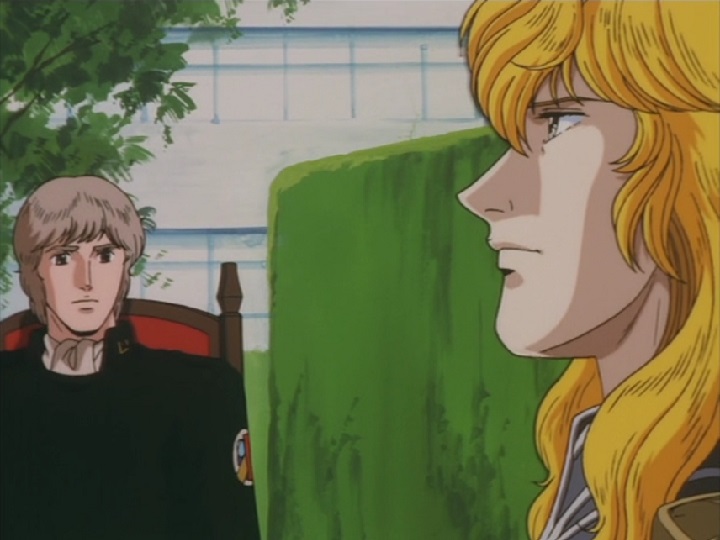
The second meeting between Minci and Reinhard: easier to swallow than the first. The other major factions of the franchise - Rubinsky's and the Terraists - continue to be its weakest elements. Neither are able to transcend cliche and it comes as no surprise that both subplots are resolved altogether too neatly and predictably. Happily, the final conflict between the Empire and the Iserlohn Republican Government is as exciting as anything seen in the franchise. Minci finally gets to show his mettle as a tactician and strategist while all the admirals and various commanders have their final moments on stage in ways that entirely suit their natures. Who dies and who survives is somewhat predictable but usually fitting. The climactic scenes veer into improbable territory - everything about the lead-up and climax of Minci's face to face meeting with Reinhard is downright bizarre - while Reinhard's illness, even if its effect on the fleet is done interestingly - is typical of the franchise by blunting the dramatic and tragic possibilities of the situation. In the end, of course, the story of LotGH is Reinhard's. Initially he is a fascinating character but by the third season his overwhelming seriousness has worn out its welcome. In addition, too much meaning is layered onto his life. Perhaps that is why this season spends so much of its time with other characters. The series ends at exactly the right point with Reinhard's story concluding, but with much hope for the future. The personalities of the surviving leaders - spoiler[Mittermeyer and Mariendorf of the empire and Minci and Greenhill of the republic] - give every indication that a more peaceful era awaits the galaxy. 
Thank you, Aylinn, for drawing Reinhard's parallel with Alexander the Great to my attention. On a technical level, the series is much improved visually with more movement and improved actions scenes. Character designs have a more three dimensional feel to them even if they are still behind the best of the 90s. The near contemporary Irresponsible Captain Tylor is much better in this regard while Cowboy Bebop - only two years away - is in an entirely different league altogether. The music, largely, but not restricted to, Beehoven, Bruckner, Mahler and Shostakovich (there's even some Stravinsky thrown in), is as wonderful and appropriate as ever. Rating: despite my criticisms I would rate the final season as excellent. Reuenthal's arc and the way the major threads of the franchise are concluded lift this season well above the others. Overall the LotGH has many faults but the sheer scope of the tale, its vast array of characters - the characterisations outside of Yang Wen-li and Reinhard von Lohengramm may have seemed slight at first but the sheer length of the series gives most of them an opportunity to show their stuff - and the political examinations, if naive at times, help it overcome its shortcomings. It is also very well structured for such a long series and is rarely anything less than engaging and frequently - especially in the gigantic battles - gripping. Because of its structure and its ongoing appeal LotGH is, as an entirety, great than the sum of its four seasons. Overall rating: very good. (The ratings for the individual seasons were decent, good, good+, excellent.) I can't end without one more screenshot. This is one of my favourite moments. It shows Reinhard's loyal and capable chief of secret police, Kesler, who isn't averse to torture and truth serums, celebrating the birth of Reinhard's heir with the Kaiserin's maid and friend, Marika. Even the chief of police can lose his composure. The two subsequently marry and live happily ever after. 
That's soot marks on their faces. You have to earn your happy ending in LotGH Last edited by Errinundra on Sun Oct 13, 2019 2:49 am; edited 1 time in total |
||||
|
||||
|
Beltane70
Posts: 3972 |
|
|||
|
Don't forget that Mittermeyer pretty much has a happy ending as well!
|
||||
|
||||
|
Errinundra
Moderator
Posts: 6584 Location: Melbourne, Oz |
|
|||
|
^
Mitterrmeyer seems to me to be a character that would have slotted in nicely as a member of the rebels. He even looks the part. I think that's deliberate, indicating that he will work well with Minci and Greenhill in the future. |
||||
|
||||
|
Jose Cruz
Posts: 1796 Location: South America |
|
|||
|
Great review of LoGH. I personally think it's the best epic war series of all time (it's not like there is much competition in the genre), which is why I regard it as a masterpiece. Although it's quite flawed and suffers from technical problems (animation and art is very subpar and the pacing is a bit slow at tiems), overall it's epic science fiction at its best.
Also, the "lameness" of the tactics gives it a charm as well. Japanese like that kind of "lame tactics" thing which I find really amusing. And how characteristically Japanese is the mentality of these characters even though it's far away from the typical "Anime setting" (tennagers in highschool). |
||||
|
||||
|
Errinundra
Moderator
Posts: 6584 Location: Melbourne, Oz |
|
|||
|
Thanks for the kind words, Jose Cruz.

Reason for watching: This - 
I meant the motorbike. Baka! Whoever would have thought that a Ducati 750SS replica of the bike Paul Smart used to win the Imola 200 would play a prominent role in an anime? The wonder of it. That said, putting a sidecar on such a narrow-focus, highly-tuned bike like a Ducati 750SS is akin to attaching a caravan to a Ferrari. Stupido! (Yeah. I get the joke, but it's still stupid.) I'm happy to confess that my love of motorbikes in general, and Ducatis in particular, got me watching this each week. With KanColle it was ship spotting; this time it's motorbike spotting. Unhappily, with no legal streams available in Australia I had to rely on other means to watch it. 
The Ducati I owned (top), plus two other models I've ridden. Clockwise from top: 500 Sport Desmo; Darmah 900; 250 Mark 3. Synopis: Sakura Hane and her friends attend high school, ride motorbikes and do things. That's all. Comments: In this review the pictures are going to dominate the text. There isn't a lot to say about the characters or the plot because neither have much substance. So let me bring up a picture of the six main characters to help me remember their names, let alone what's distinctive about them. 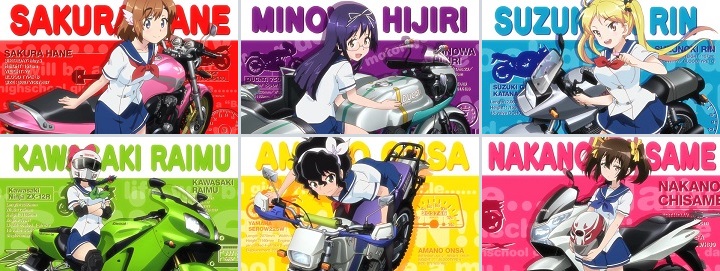
The pics, from the OP, list the important facts for each character, such as length, width, height, engine type and displacement. No, wait. That's the motorcycles. It's the other list: birthday, height, weight, blood type and breast, waist and hip measurements. What about the colour of their pubic hair? You left that out, comrades. Seriously, let me see if I can recall some of their behavioural traits from the show. So, clockwise from top left... Sakura Hane (red background) - she's a somewhat toned down genki girl who takes everything at face value, is easily enthused, prone to sentimentalism, plays the neophyte for the others to thrust their competing preferences upon and, thanks to her naivete, gains a reputation for left-field suggestions. Hijiri Minowa (purple) - a ditzy rich girl who is chauffered in her sidecar, who thinks anything can be bought with money including motorcycle licences and who desperately wants to be a delinquent, if only she knew how. Rin Suzunoki (blue) - an excitable idiot with a monomania for her favourite motorcyle brand. Chisame Nakano (pink) - a younger, sullen, unlucky girl with a prodigious racing talent so long as the bike has a seat low enough for her diminutive stature and who has an amazing ability to lean her bike over, even when it isn't moving. Onsa Amano (yellow) - a scheming, irritable girl who runs the school motorbike club but who inevitably runs foul of Rin's excitability. Raimu Kawasaki (green) - a mysterious girl who never removes her helment (even when wearing a bathing costume), who has been a student at the school for many years and who communicates by handwritten messages. That's about as interesting as they get. None of them develop as characters; none of the relationships are explored; none of them have anything notable to say. They just do things with their bikes. Occasionally the show pulls out a gag. Some of the gags are funny. Bakuon!! is a rung below even Kancolle, which at least had an overarching story line and a preposterously hilarious premise. What the two share is a cast of fairy floss, vacuous girls, with no counterparts that I've met in my own life, and a gimick - motorcycles and moribund warships respectively. What next? Girls and lathes? Girls and stamp collecting? Girls and abalone fishing? Girls and vacuum cleaners? That's it! Vacuon!! (You saw that coming, didn't you? Or were you sucked in?) 
My Japanese bikes (with a guest appearance from a very young yours truly and Albert Einstein). Clockwise from top: Yamaha FZ750; Yamaha XS360; Kawasaki GPZ550. For this (former) long-time motorcylist, there were, admittedly, moments when Bakuon!! had intimations of what it is that is so beguiling about the activity. From time to time it captured those little things that are a part of living with something as demanding and unforgiving as a motorcycle. Bakuon!! is it at its best when it brings these elements to the fore: the emotional high of high speed cornering on windy roads; the amazing power to weight ratio (my Yamaha FZ750 could get from 100 km/h to 200 km/h in about the time it takes to pour a cup of coffee); the tedium and zen of touring long distances (Australia is so god-awfully flat!); that despairing moment as your bike falls of its sidestand; the dumb brand rivalry between motorcycling friends; the, nevertheless, mateship between motorcyclists; or the way riders come to treat their bikes almost as living things (hey, each of my motorcycles had more character than the Bakuon!! girls). I must also give kudos to one area where the Bakuon!! shines - the CGI rendering of the motorcycles is superlative. As far as the bikes go, the show is eye candy. The cooling fins on the rear cylinder of the Ducati seem too squared off for my liking, but I'm being a nerd, so you can ignore that. That sort of quibble actually demonstrates how superbly done the bikes are. The art form we love so much, which has given us these wonderful characters over the decades... ↓ 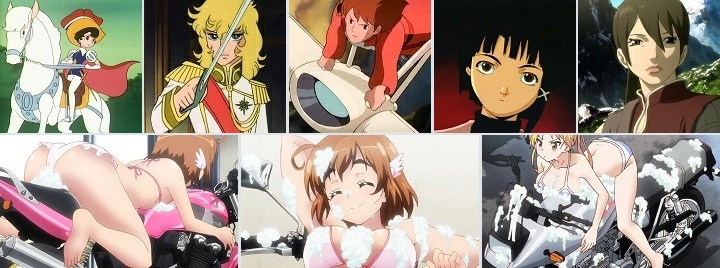
... now gives us this.↑ Bakuon!! is so dull it's no wonder the scene is a highlight. So, yes, Bakuon!! has utterly reduced anime girls to the most basic level: marketable, disposable objects, with easy, simple selling points for the consumer to choose, just like so many Japanese motorcycles. Nevertheless, I've ridden some exceptional Japanese motorcycles. Likewise, I've seen some amazing anime with unique, memorable female characters. Bakuon!! isn't one of them, with its production line characters and gags. It's crap. Watching Bakuon!! is like watching goldfish in their tanks. You know they're alive because they're moving and they require feeding, but you're never sure if there's any active intelligence involved on the part of the fish or any, for that matter, involved in watching them. All the same, there's something inexplicably compelling about it. It might be crap but I've seen worse. Dull is much, much better than offensive or reprehensible. Rating: Not really good. The occasional funny gag and the likewise occasional distillation of what makes motorcycling magical lift Bakuon!! from its usual tedium. Some serious effort at customising the central characters to be something beyond mere bog-standard models (and I'm referring both to the bikes and the girls) wouldn't have gone amiss. If the marketers get around to releasing a figurine of Hijiri and the Ducati 750SS I'll buy it. I'll throw Hijiri in the bin, but the bike will be the pride of my anime figurine collection. 
All motorcycles should be red. Fire-engine red. Racetrack red. Blood red. Socialist red. Last edited by Errinundra on Sun Oct 13, 2019 3:01 am; edited 2 times in total |
||||
|
||||
Alan45
 Village Elder Village ElderPosts: 10022 Location: Virginia |
|
|||
|
I had to give up on Bakuon!!. To begin with, I don't have your attachment to motorcycles. The only one I ever owned was a Honda 50 and I doubt that even qualifies as one. I did find the washing/bathing suit episode to be a bit ridiculous, not because of the cheesy fan service, but simply because most of a motorcycle had projecting bits of metal, screw heads and such, even in the apparently smooth areas. I kept expecting them to start bleeding from multiple scratches. When they got to that silly race, I just gave up as I realized I didn't care what was going on.
You mentioned Kancolle I was unable to get beyond the previews on that. I saw the name of one of the girls representing a destroyer. I realized it sounded familiar and sure enough it is currently resident on Iron Bottom Sound. I looked up a couple of the others and found they have all been dead longer than I've been alive. Much too sad even to play with. |
||||
|
||||
|
Jose Cruz
Posts: 1796 Location: South America |
|
|||
Really funny analogy. That's the way I feel these days about most stuff (TV, movies or manga). The challenge now is to find really interesting stuff, stuff that's memorable like LoGH, for example. |
||||
|
||||
|
Night fox
Posts: 561 Location: Sweden |
|
|||
|
^ For me, LotGH is something that had a lot of potential, but in the end wasn't executed wery well. Everything about the series seems so average. The characters are mostly bland, and in the few cases where the voice actors could've made a difference, such as with Wen-li and Oberstein, they failed to make them really shine. I just never felt any chemistry between the characters. There are evidently some romantic pairings in this series, but there sure isn't much in the way of actual romance to show for it, so what's the point?
The animation and the juvenile attempts at strategy have already been mentioned and imo there's too much focus on the battles in general (let's not even mention the random battleaxe gorefests I believe I was being generous when I rated it "good", but I normally lower my initial ratings after a few months when the titles have finally "sunk in" properly, so I might lower it to "decent" in the not too distant future. Imagine if you could freely insert Hunter x Hunter-characters into the LotGH-universe - now that's a series I'd love to watch! *removes van Lohengramm, Kircheis, Oberstein, Mittermeyer and Reuental - inserts Meruem, Komugi, Pouf, Youpi and Pitou* *Also removes the Rosenritter - inserts the Phantom Troupe* |
||||
|
||||
|
Errinundra
Moderator
Posts: 6584 Location: Melbourne, Oz |
|
|||
|
@ Alan45,
In my review of KanColle I included a list of the fate of the namesake ships of all the characters in the series, including how many died when they were sunk. The total Japanese death toll represented by the KanColle girls is, conservatively, 18,420 sailors. @ Jose Cruz, There's still great anime made. The most recent anime that I've rated excellent or better is ERASED from earlier this year. @ Night fox, I've never seen Hunter x Hunter but, other than the parallels you make with that show, I generally agree with you assertion about Legend of the Galactic Heroes, but I think the overall achievement transcends the limitations of its character and strategic visions. As I said, the whole is greater than the sum of the parts. Anyway, onto the next housekeeping review, this time from 5 October 2013. There are minor changes to the text, but I haven't reduced the images. They're altoghether too gorgeous. I watched this film again tonight, via DVD. I don't care about its shorcomings; the scenery porn thrills me as much as ever. The review is brief - it was written immediately upon my return from the cinema. The Gardens of Words Reason for watching: I try to watch all cinema screenings of anime in Melbourne. I saw this at Cinema Nova in Carlton as part of Madman's 2013 Reel Anime Festival. It was screened as a double feature: Ghost in the Shell: Arise - Border 01: Ghost Pain started a few seconds after Carden of Words finished. It was quite a jarring change in tone. Synopsis: Takao Akizuki is a serious fifteen year old boy whose dream is to handcraft shoes. On rainy days he wags school to visit Shinjuku Gyoen park where he sketches shoes and dreams. There he meets 27 year old Yukari Yukino who, similarly, is taking extended breaks from her employment without every explaining why. The two meet whenever it rains and, it being a Makoto Shinkai movie, they fall in love. When they discover their connection in the real world outside the park they realise that their love, while genuine, must remain beyond reach. Comments: After the worthy failure that was Children Who Chase Lost Voices, Makoto Shinkai has returned to his stock in trade and directed a more characteristic tale of unrequited love. Good thing too because this is his best effort yet along those lines, giving us visuals more stunning than ever before, his first decent character designs, keeps the sentimentalism to a minimum (by his standards), and creates one of the most tender sexual moments I've ever seen in an anime - when Takao finally touches Yukino's feet so he can measure them for the shoes he plans to give her. That's a new element for Shinkai, introducing a physicality not previously apparent in his works. I only hope he continues his explorations in that direction. His approach to more carnal scenes could be fascinating. 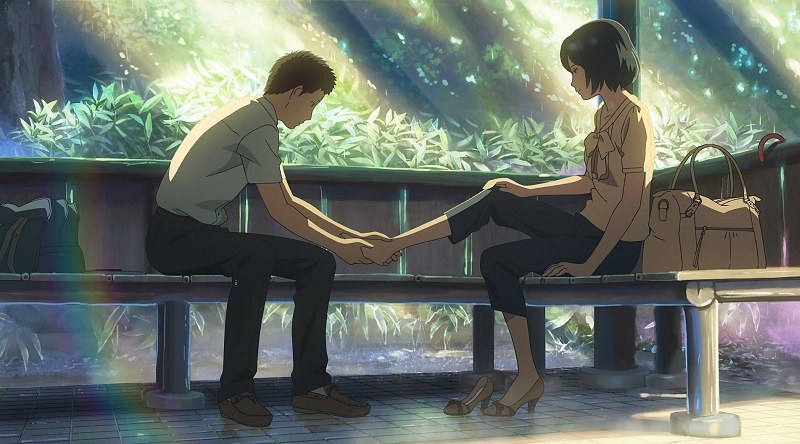
Takao and Yukino. Last year's Shinkai offering at Reel Anime, Children Who Chase Lost Voices, while pretty, was, visually, something of a disappointment. Both From Up On Poppy Hill and Wolf Children were at least as good. This time around I was blown away. Even the wonders of 009 Re:Cyborg couldn't put it in the shade. I particularly loved Shinkai's play of leaf against water, emphasising the intersection of different elements or worlds. (Like much of anime, Shinkai's metaphors can be unsubtle.) The artwork is so detailed that I sometimes wondered if I were actually viewing life action film. This website shows key locations and the photographs upon which they were based. Sure, the pictures are lovely but I'm left wondering precisely how creative Shinkai is being. You may even argue that Flowers of Evil is actually being more creative in its use of rotoscoping. Then again, people will give more latitude to a butterfly than a bush fly. Like them, I'll forgive him because, on the big screen, the images are so lovely it doesn't really matter. 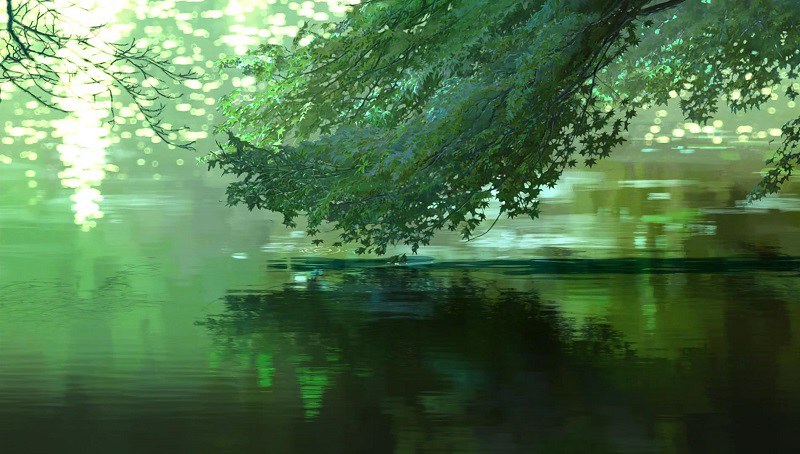
Simply magnificent. Another plus is that the film is only 46 minutes long. Short Shinkai is good Shinkai: he can be drearily self-indulgent at times. Not so here. The Garden of Words is poignant, to the point and never overstays its welcome. Although, when we finally learn Yukino's actual profession and how it connects to Takao, the film's lyricism is suddenly replaced by a rather more everyday prose. Give me a Japanese garden over a Japanese high school any day. Again, all is forgiven when the two lovers finally embrace. CHRIST! That must have been cathartic for Shinkai! How many hours of anime has he given us of yearning, worry, self-reflection, angst, loneliness, endless train journeys, separations and dreams before he gets his pair of would-be lovers to finally hold each other? WOOHOO! Go, Makoto! That said, he still can't give us a decent female character. As she herself admits, Yukino is "saved" by Takao. That's right. Once again the Shinkai woman is the object of the male's protection. You know, women actually have their own agendas. In fairness I can see how, from film to film, he is developing his craft and pushing his boundaries. This is one boundary he really needs to crash through before his films can be genuinely counted as great. Rating: very good. Shinkai's best effort to date, easily. Last edited by Errinundra on Thu Jul 13, 2017 7:21 am; edited 1 time in total |
||||
|
||||
|
Zin5ki
Posts: 6680 Location: London, UK |
|
|||
|
Hooray! Another Errinundra review of a film I recently saw! Every fan of Shinkai's will likely agree that The Garden of Words was a welcome return to form. The lyricism with which he paints the characters' emotions into the swirling landscapes surrounding them is as comforting as it is familiar. Had the film not been disappointingly stunted by Yukino's climactic loss of fortitude, something you keenly noticed, this work would have been amongst Shinkai's strongest pieces. Voices of a Distant Star will always be my preferred work of his, principally for its score and its ultimately devastating lightness, though it seems we are still on quite the same page here.
|
||||
|
||||
|
stilldemented
Posts: 232 |
|
|||
|
I've only ever watched Garden of Words and 5 Centimeters per Second so I have very little to sustain my opinion, but I think it's interesting how Shinkai seems to like telling stories that have an incomplete completion. He likes to focus on characters that have an emptiness of sorts and he ends his movies without completely fulfilling them or leaves things on a lingering question of what might have been or what will be.
I could be completely off the mark with that though. Two experiences doth not an expert make. But I've enjoyed both of the movies for different reasons. The artistry is beautiful and Garden of Words usage of rain as a symbolic washing away to the bleakness the two characters feel ends up being a neat touch. Especially when the sun comes out at the end. Then there's the whole motif of a boy who wants to make shoes meets a girl who's stuck and can't move forward. Garden of Words is a simple movie, but it manages to be a lovely experience. It knows what it wants to say, says it, and then exits the stage. And all that green. So much green. Very pretty scenery. That's all I got. Random, I know. But yay! Something I've seen is covered. |
||||
|
||||
|
Errinundra
Moderator
Posts: 6584 Location: Melbourne, Oz |
|
|||
|
@ stilldemented,
May I suggest you follow Zin5ki's recommendation and watch Voices of a Distant Star next. As you watch it, please be aware that Shinkai did it on his own on his PC. It's an amazing effort. **** It's the eve of the Federal election in Australia. The two major competing parties are the centre-right Liberal Party and the centre-left Labor Party. The House of Representatives, where government is formed, is made up of 150 single-member electorates of roughly equal size, while the Senate has 76 seats - 12 from each of the six states, regardless of population, and 2 from each of the two territories. Pundits and polls suggest the Liberal Party will be returned with a reduced majority. I vote in the electorate of Batman (true!) in the state of Victoria. According to the Australian Broadcasting Commission's survey of voters, I live in the most left-leaning seat in Australia. Likewise, Victoria is the most left-leaning state. Traditionally, Batman has been a safe Labor seat but the Greens Party has rapidly increased its vote over the last decade. They are given a chance of winning this time (the neighbouring electorate - Melbourne - is currently held by the Greens). As I'm working tomorrow I voted early. I'm fairly representative of the seat, having previously been active in the Socialist Left of Labor Party and worked for a Labor member of the Victorian Parliament. Like many in the area I have switched my allegiance to the Greens due to their more left-wing social stances. I expect to be disappoined tomorrow evening. **** Over July I intend to post four reviews of anime I watched prior to my great anime awakening when I saw Paprika at the Melbourne International Film Festival in August 2007: Kimba the White Lion (as a child in the 60s), Legend of the Overfiend (circa 1990), Howl's Moving Castle (September 2005) and Tales from Earthsea (June 2007). It's likely the reviews will be punctuated by housekeeping reviews from the What are you watching right now? thread. First up, here's a classic 1960s anime based on Osamu Tezuka's manga, made by his anime company Mushi Production and directed by Shigeyuki Hayashi (better known as Rintaro - Galaxy Express 999, Labyrinth, Metropolis) and Eiichi Yamamoto (Tales of the Street Corner, Cleopatra, Belladonna of Sadness). 
Kimba the White Lion Reasons for watching: I recall watching four anime series (one barely - Marine Boy) way back in the infancy of television anime. It needs to be borne in mind that colour television didn't arrive in Australia until 1 March 1975, so even Kimba and Marine Boy were watched in black and white. Of the four (see image below) Kimba was the only one to seize my imagination, being, for a time, my favourite television show. Given that I was born in 1958 (my lifetime encompasses all full colour anime ever made, just) and that my recollections of watching it involve the house I lived in until the week of my tenth birthday then I'm looking at the period 1965-8. Oddly enough, even as a kid I knew these shows were Japanese. Madman and Right Stuf co-produced a box set of the original English dub in 2005 and I've been umming and ahing about buying it for a few years. My fear has been that It wouldn't stand the test of time. To be honest, nostalgia hasn't really been a factor - all I remembered was the theme song, the four main characters, a scene where Kimba convinces his fellow carnivores to become vegetarian (more on that later) and a creature called a flyger (even as a child I was attracted to wordplay). Not long ago I finally decided to buy the series, only to discover that Madman no longer had the complete series in stock. Upon receiving my order from Right Stuf I discovered to my amusement that the box set was actually authored my Madman and simply marketed in the US by Right Stuf. Good thing I've got region cracking software. 
Left to right: Astro Boy, Gigantor, Kimba the White Lion, Marine Boy. No, I don't want to sit through the other three for the sake of this thread. Synopsis: After the shooting of his father by hunters and the drowning of his mother at sea en route to a zoo, Kimba escapes back to his jungle where he leads the other animals in creating a utopian kingdom based on co-operation and endeavour. He and his friends face trials, meet dangerous adversaries and have surprising adventures. Subplots that run throughout the series involve: a rival lion, Scar, who, with the support of the his hyena and black panther minions, tries to usurp Kimba's authority; a ranger so enamoured of Kimba's project that he lives with the animals; an amnesiac woman with a whip who sprouts ever more fantastic schemes to capture Kimba; a budding romance with Kitty, a young lioness from a nearby lion kingdom; and the care of 2½ thousand years worth of preserved hides of Kimba's white lion ancestors. Comments: The first thing that should be noted, now that I've finally got to the review proper, is that I've only ever watched the American dub version, which is the only option on the DVD. Even without seeing the original, it clearly takes liberties with the source material. Simply comparing the intros gives an indication of how much could be taking place. The Japanese intro is epic in scope with specially made animation and operatic music. The American intro, which is also used in the end credits, uses clips from various episodes along with sections of the Japanese ending animation (which are all taken from the episodes, in any case). The American music is a jaunty song derived, appropriately enough, from The Lion Sleeps Tonight. That said, I think the American intro more closely matches the lighter tone of the episodes themselves. To that can be added liberal English language wordplay in the script; giving almost all the characters English names bearing little resemblance to the originals; American terminology that is occasionally downright incongruous - there are no alligators or lynxes in Africa, for example - and, in the 1965 English language broadcast, completely recasting the episode order (though the DVD restores the Japanese episode order). In my blissful ignorance I must say I don't mind the names, the jokes or the occasional zoological slip-up, but I make the caveat that the feel and emphasis of this version may differ from its Japanese counterpart. 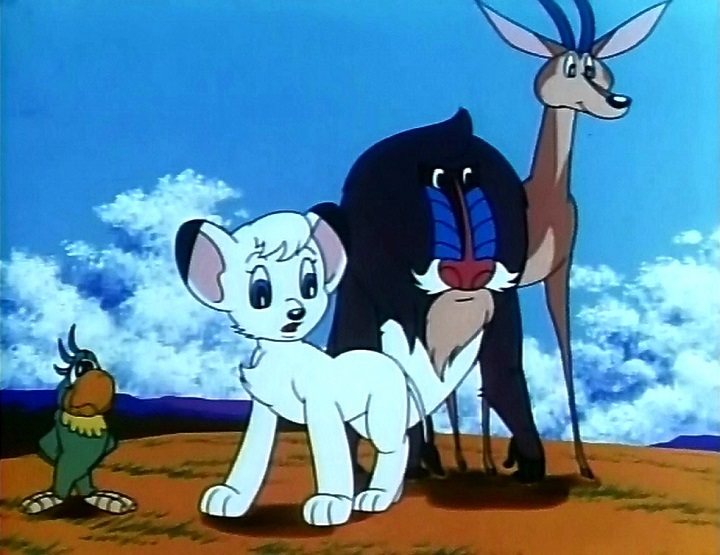
Polly Cracker, Kimba, Danil & Bucky. Kimba is the eternal optimist: no task is too big, no obstacle insurmountable, no foe can't be brought down. With his huge eyes and oversized head and paws he's adolescent and kawaii decades before its time. He's also resolute, hard-working, principled and charismatic. His fringe and steely eyes often reminded me of Joe Yabuki (Ashita no Joe), also from Mushi Production. From the catastrophe of his early beginnings he rebuilds a jungle society where everyone pitches in for the greater good. Sounds like a certain nation in the 1960s? Maybe. Don't think for a moment that Kimba is earnest. His youthfulness, ocassional clownish behaviour, the goofy humour and his cheery optimism ensure he doesn't wear out his welcome. His closest companions are a wise and foolish old baboon, Danil, whose voice actor does a fine impersonation of Walter Brennan; Polly Cracker, a slapstick comic relief parrot; and goofy-voiced Bucky, an impossibly striped gazelle who is smarter than he sounds and who runs the jungle school. The jungle school is emblematic of the show. These animals are into self-improvement. Kimba convinces the other carnivores, for the sake of interspecies harmony, to become vegetarian. He and the other big cats trying to eat grass for the first time is the only scene I remember after fifty years. The animals create a collective farm, build a communal canteen and place the welfare of their fellow animals and the conservation of their jungle as their priorities. Now, let me see. I'm vegetarian, vote Green and I'm an old leftwinger who works for a mutually owned company. I wonder. Even though I remember so little of it, did Kimba the White Lion have a formative influence on me? Don't be put off by the political undertones, though. Kimba doesn't throw them in your face. In any case you can choose to read into their activities fine examples of entrepreneurial spirit and good old get up and go. As entertainment Kimba is variable. For the most part the episodes tell stand alone stories. Villains (animal and human) reappear from time to time while the Roger Ranger/Captain Tonga tale is played out in occasional episodes over the course of the series. The best episodes are those that revel in Osamu Tezuka's signature goofy yet surreal humour, such as Kimba's trip to a city to find Kitty's Uncle Speckle Rex, culminating in Kimba's death defying attempt at driving a truck in pursuit of the older lion who is clinging for dear life to a hurtling locomotive's cowcatcher. Another example is a sea lion who turns up in Kimba's jungle and invites him to travel cross country to view the Indian Ocean. Speaking of geography, and I can't blame Fred Ladd's reinterpretation for this, distance seems to be no obstacle to either Kimba or the scriptwriters. Kimba can travel from Mount Kilimanjaro to the Congo River in a day. A trip to the Atlas Mountains in north-west Africa? Build a raft and paddle there. Kimba even spends an episode in Paris. For all the hijinx Kimba the White Lion also has its moments of grandeur, with several scenarios recalling the lost world mysteries popularised by Henry Rider Haggard's Allan Quatermain and Ayesha romances. 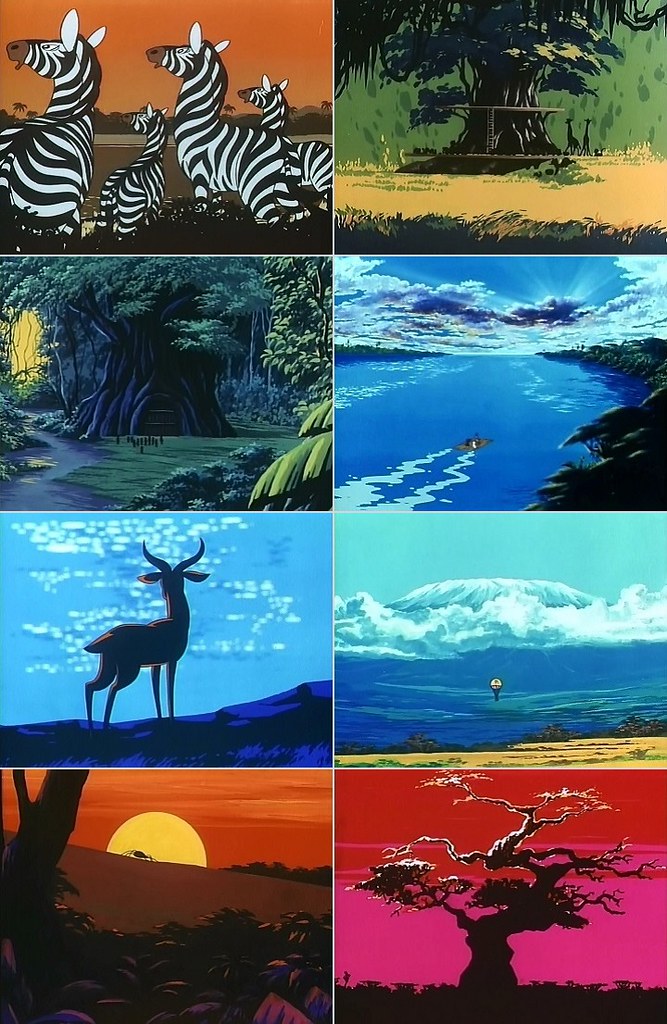
The scenery is simple but effective. The Rule of Thirds gets a thorough workout. Visually Kimba the White Lion is surprisingly good. The character animals owe much to Disney, with the addtion of Tezuka's trademark huge eyes, oversized feet and paws, and frequent ground up persectives that give the characters an heroic aspect. When required the animals can be given a more naturalistic appearance, as you can see above in the images of the zebras and the gazelle. The scenery shots are often outstanding. Mushi Production uses its limited means very effectively. Typically the colour palette in a shot is limited, but the imagery is highly expressive. Animation is saved by re-using sequences over and over. One frequently used ploy is to have one moving sequence set to many different backgrounds. Another is the old technique of iterating a small number (from one to three) moving animals many times in the one image. Look closely at the fifty animals stampeding on screen and you'll notice there are only three repeated many times. The upside is that there is more movement than in many modern anime, even if the tricks are apparent. Movement is always engaging, so the makers get away with it. There are problems, though. Some are due to the age of the material. One episode is dark, while another has fuzzy outlines. That does mean, though, that fifty episodes are crisp and bright. Not bad for something so old. More alarmingly, some of the animation and artwork shortcuts are glaring, such as the visible seam between the mouth and the face of characters when an animated mouth is added to a static body. Worse still is this notable example of stitching together artwork: 
Kimba and Kitty negotiate an awkward seam in the backround art. Kitty's skin-coloured fur provides moments of unexpected sensuality. Given that the manga was published from 1950 to 1954 and the television series aired in Japan in 1965 and 1966, it's surprising how few Africans appear in it. When humans have a role they are, 95% of the time I would estimate, of Caucasion appearance. The important recurring characters are visitors from North America or Europe. Whole cities are comprised of white people. I find that surprising when you consider that between 1950 and 1966 somewhere between 35 and 40 African nations gained their independence from their colonial overlords. It's as if the makers didn't want to spoil the romantic view of Africa held by their perceived audience. In fairness, the Africans that do appear are presented, for the most part, sympathetically, though they are never more than tan in colour. Given that almost all the humans are portrayed goofily then I suppose that such representations of Africans would seem condescending at best and demeaning at worst. I'll be charitable and say the series is a signpost of less enlightened times. Nevertheless an Africa with pretty much only white people is bizarre. On a brighter note, the orchestral soundtrack composed by Isao Tomita, who died not quite two months ago, complements the expressive background imagery nicely. The music has mid-century Russian feel to it. In 1965 that was a daring use of a, then, recent idiom in composition. A sad irony of Kimba the White LIon is that it has no modern anime descendant. Tezuka's Astro Boy and Princess Knight have had a much more profound influence on the anime we watch these days. It seems that, with Otaku viewers replacing general viewers as consumers of anime in the 80s and 90s, the anthropomorphised animal lost out to robots and beautiful girls. More ironic is Kimba's impact on American animation. Happy Feet, Madagascar, Finding Nemo, not to mention The Lion King, follow a tradition set by Kimba, which, itself, was inspired by Walt Disney's and Warner Brothers' earlier animal characters albeit with far greater narrative ambition. What goes around, comes around. Rating: Based on my original recollections I had rated Kimba the White Lion as so-so. Now that I've seen it again, I've upgraded the rating to decent. I wouldn't recommend it to the current day anime fan but I will say that it is probably better than you think. Last edited by Errinundra on Sun Oct 13, 2019 3:21 am; edited 3 times in total |
||||
|
||||
|
All times are GMT - 5 Hours |
||
|
|
Powered by phpBB © 2001, 2005 phpBB Group
